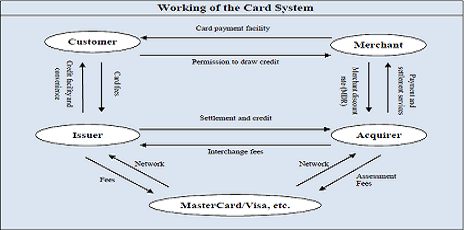Trade started with exchage of goods for goods commonly known as Barter in mordern times. Common medium of exchage in the form of Currency was introduced by earlstwhile kingdoms and Cash currency prevailed for a long time. The problem of carrying loads of Cash currency and introduction of Banking system lead to usage of negotiable instruments mainly Cheques which replaced cash to a large extent. Risk of honouring the Cheque lead to introduction of Demand Draft and Promisory Notes which had an element of Credit. Increase in trade lead to increase in Travel which lead to introduction of Travellers Cheque.
Introduction of Credit Card-Plastic Money in 1949
Frank X. McNamara in US came out with an idea for customers to have just one credit card that they could use at multiple restaurants. McNamara discussed the idea with two colleagues and the three pooled some money and started a new company in 1950 which gave birth to the Diners Club.The first Diners Club credit cards were issued in 1950 to 200 people ( friends and acquaintances of McNamara) and accepted by 14 restaurants in New York. The concept of the card grew and by the end of 1950, 20,000 people were using the Diners Club credit card. The Diners Club credit card is considered the first modern credit card.Today in India alone there are 20 million(2 crore) Credit Card holders and the number is increasing by 18% Per Annum. Credit Card combines all the benefits of the above mentioned medium of exchage including liquidity and credit facility and excludes demerits such as theft,inconvinience of carrying etc, hence will continue to be a powerful mode of exchage.
Although Net Banking had been a later introduction has not been able to substituted Credit Card.
The detailed working of Credit Card is explained in the later section of this page meanwhile choose the Credit Card of your choice.
Compare CREDIT CARD and BUY CREDIT CARD Free & Paid Card
One Stop Shop for all the Credit Cards Offering On-line Application Facility.
Visit www.creditcards4u.in a 100% Secure and Safe Website
(Only Credit cards of Banks providing Online Application are included, while credit cards of Banks not providing Online Application facility is out side the purview of our subject.)
The system consists of a customer who holds a credit card from his issuing bank (called issuer), a merchant who has been given the facility of accepting credit cards by his acquiring bank (also called acquirer) and MasterCard/VISA, etc., whose networks are being used. In this system, first a merchant who decides to accept credit or debit cards in exchange for goods or services establishes a merchant account by forming a relationship with an acquiring bank. This relationship enables the merchant to receive sale proceeds from credit card purchases through credits in his account. However, while receiving such credits, the acquirer applies a Merchant Discount Rate (MDR), which is paid by the merchant to the acquirer in consideration for card acceptance services. A MDR is the percentage of sales that a merchant pays to the acquiring bank to process credit card transactions.
This rate generally varies from 1% to 3%. On the other hand, the cardholder pays charges in form of annual fee, finance charges, late payment charges, etc. to his card issuing bank. The risk of default by credit cardholders is borne by the issuing bank.
The Interchange fee on a purchase transaction flows from the merchant acquiring bank to the card issuing bank. The figure below explains the working of the Card System in India.
 The settlement and credit transactions between the issuer
and the acquirer are done using the network of
MasterCard/VISA, who gets a share of the fee in exchange. In India,
though competition guides acquirer-merchant pricing policies, it is
generally understood that Interchange fees is one component of the
MDR established by acquirers. The implementation of proper
Interchange rates is necessary and also very crucial for
maintaining a strong and vibrant credit card payments network. The
other major component of the MDR is the fee imposed by the acquirer
which is retained by the acquirer to meet its own expenses. It is
quite common to see a transaction at a merchant establishment
involving a bank which is both the acquirer and the issuer. In such
a situation it may be possible to reduce the Interchange fee since
the payment network is substantially reduced. However, such reduced
Interchange fee is not generally passed on to the
merchants.
The settlement and credit transactions between the issuer
and the acquirer are done using the network of
MasterCard/VISA, who gets a share of the fee in exchange. In India,
though competition guides acquirer-merchant pricing policies, it is
generally understood that Interchange fees is one component of the
MDR established by acquirers. The implementation of proper
Interchange rates is necessary and also very crucial for
maintaining a strong and vibrant credit card payments network. The
other major component of the MDR is the fee imposed by the acquirer
which is retained by the acquirer to meet its own expenses. It is
quite common to see a transaction at a merchant establishment
involving a bank which is both the acquirer and the issuer. In such
a situation it may be possible to reduce the Interchange fee since
the payment network is substantially reduced. However, such reduced
Interchange fee is not generally passed on to the
merchants.
The banks and
MasterCard/VISA generate revenue and make profit in the credit card
system by charging Interchange fees. In the western countries big
merchants have already realized this and are in union in their
demand for reduction in Interchange fees. MasterCard USA,
moving towards being more transparent, has now explicitly
placed on it official web site the Interchange
Rates.
Source: Brief extract of paper publiished by Shri Ashish Das, Dept Of Mathematics IIT Mumbai, 10 Nov 2008